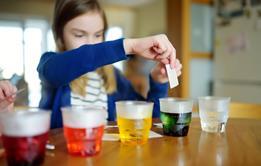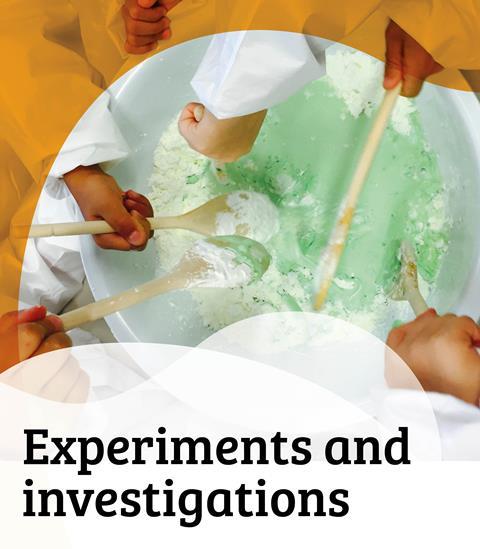In this activity, learners create rainbows using drops of red cabbage indicator homemade indicator paper using items you can find in the kitchen cupboard
In this video, education coordinator Rosie demonstrates how you can make red cabbage indicator, a dark purple liquid which changes colour when it comes into contact with an acid or an alkali, and use it to create rainbows. This simple activity can be set for learners to try at home with a responsible adult or used as a classroom experiment.
Equipment list
- Red cabbage
- Paper and plastic wallet
- Kitchen roll
- Lemon juice (acid)
- Soda bicarbonate (alkali)
- Washing powder (alkali)
- Sieve
- Pots and pans
- Paint brush
Health and safety
- If this activity is set for the students to try at home it is important that a responsible adult is present at all times.
- Take care when using knives and boiling water.
- Do not drink the red cabbage indicator.
- Remember that some household substances can be harmful – make sure you read any warnings on the bottle or packet before you decide whether or not to use it.
Activity instructions
Preparing the red cabbage indicator and the homemade indicator paper
- Take three leaves of the red cabbage and chop them into small pieces.
- Put the chopped up red cabbage into a pan, add enough water so the cabbage is just covered. Boil the cabbage for about ten minutes. Another way to make the indicator is by blending the leaves or leaving them to soak overnight. But if you boil the cabbage, then you can make indicator and have cabbage for your tea!
- Once the red cabbage and the water is cool, put a couple of pieces of kitchen roll in a sieve and drain the red cabbage through it, collecting the water in a bowl underneath. The red cabbage will have dyed the water purple creating indicator, and will also stain the kitchen roll to make the indicator paper.
- Leave the dyed kitchen roll to dry.
Preparing the acids and alkalis you find in the kitchen
- When using liquids, such as lemon juice, pour a small amount into a container.
- When using powders such as washing powder or bicarbonate of soda, mix a small amount with some water in a container.
Creating rainbows using drops
- Draw a rainbow onto a piece of paper and put it inside a poly pocket.
- Use a paintbrush to drop the red cabbage indicator onto the rainbow.
- Use a separate paintbrush to add some acids and alkalis that you can find in your kitchen to the drops of red cabbage indicator. Watch as some of the colours of the rainbow appear.
Creating rainbows using homemade indicator paper
- Once your homemade indicator paper is dry you can paint a rainbow onto the paper using the acids and alkalis that I’ve found in the kitchen.
- Add an acid or an alkaline onto your paintbrush and then paint it directly on the indicator paper. You should see that the paper instantly changes from purple to a colour – the colour will depend on which acid or alkali is used.
Explanation
Red cabbages contain anthocyanins, these change colour when they come into contact with an acid or an alkali. For example, acidic lemon juice turn the red cabbage indicator line, alkaline washing powder turns it green and alkaline bicarbonate of soda turns it blue. Have a go with your learners and discover what other acids and alkalis you can find in the kitchen cupboard.
Additional activities and lesson notes
Try making a pH ‘rainbow wand’ and find context and guidance for using these experiments in the classroom, during open days and for public events. Explore the additional resources at the bottom of this page and check out the lesson notes below for more information.
Skills development
Children will develop their working scientifically skills by:
- Drawing conclusions and raising further questions to be investigated, based on their data and observations
- Asking their own questions about scientific phenomena
- Selecting and planning the most appropriate ways to answer questions, including:
- Grouping and classifying things
Learning outcomes
Children will:
- Group substances according to whether they are acidic, neutral or alkaline
- Compare and group together everyday materials on the basis of their properties
Concepts supported
Children will learn:
- That substances can be acidic, neutral or alkaline, and that tests can be performed to determine which of the three a substance is
Suggested activity use
You can use the activities described in the ‘Rainbow cabbage’ and ‘Red cabbage indicator experiments’ handouts for a whole-class investigation, allowing children to group substances into acids and alkalis. They will provide opportunity for discussion and questioning.
Alternatively, you could use this resource as part of a science week or at a science club.
Practical considerations
The red cabbage juice indicator can be prepared the prior to any lesson, which will save time.
A range of different substances to test will be required.
Also check out
- Download the Rainbow cabbage handout, originally designed to be shared with children and their parents or guardians during the Cambridge Science Festival 2013. It provides simple instructions for making and testing red cabbage indicator paper, and includes a colour comparison chart.
- Download the ‘Red cabbage indicator experiments’ handout as a PDF or editable Word document for guidance on how to do the ‘rainbow wand’ experiment using red cabbage juice, plus further background information about pH, acids and alkalis.
- More simple experiments using everyday equipment which your learners can try at home or you can bring to the classroom on our YouTube playlist.
- Read the CLEAPSS guidance on practical activities for pupils at home during extended periods of school closure, GL339.
- Read the SSERC guidance for primary home learning.
Downloads
Red cabbage rainbows - teacher notes
Editable handout | Word, Size 90.64 kbRed cabbage rainbows - teacher notes
Handout | PDF, Size 0.11 mbRainbow cabbage handout
Handout | PDF, Size 0.1 mbRed cabbage indicator experiments
Editable handout | Word, Size 48.34 kbRed cabbage indicator experiments
Handout | PDF, Size 0.13 mb
From kitchen to classroom

Simple chemistry experiments using kitchen cupboard equipment. Use in the classroom or set as an activity for learners to do at home with a responsible adult.
































1 Reader's comment